steering FIAT DUCATO BASE CAMPER 2015 Owner handbook (in English)
[x] Cancel search | Manufacturer: FIAT, Model Year: 2015, Model line: DUCATO BASE CAMPER, Model: FIAT DUCATO BASE CAMPER 2015Pages: 367, PDF Size: 19.73 MB
Page 11 of 367
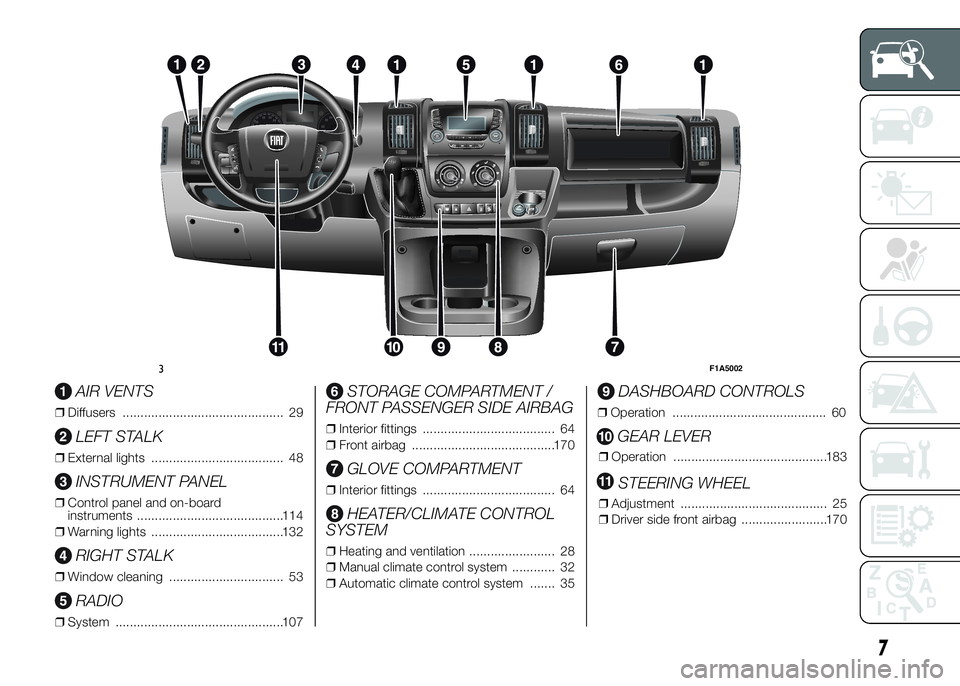
.
AIR VENTS
❒Diffusers ............................................. 29
LEFT STALK
❒External lights ..................................... 48
INSTRUMENT PANEL
❒Control panel and on-board
instruments .........................................114
❒Warning lights .....................................132
RIGHT STALK
❒Window cleaning ................................ 53
RADIO
❒System ...............................................107
STORAGE COMPARTMENT /
FRONT PASSENGER SIDE AIRBAG
❒Interior fittings ..................................... 64
❒Front airbag ........................................170
GLOVE COMPARTMENT
❒Interior fittings ..................................... 64
HEATER/CLIMATE CONTROL
SYSTEM
❒Heating and ventilation ........................ 28
❒Manual climate control system ............ 32
❒Automatic climate control system ....... 35
DASHBOARD CONTROLS
❒Operation ........................................... 60
GEAR LEVER
❒Operation ...........................................183
STEERING WHEEL
❒Adjustment ......................................... 25
❒Driver side front airbag ........................170
RADIO
MEDIA
PHONEINFO
A-B-C
MENU
123 4 56
3F1A5002
7
Page 13 of 367
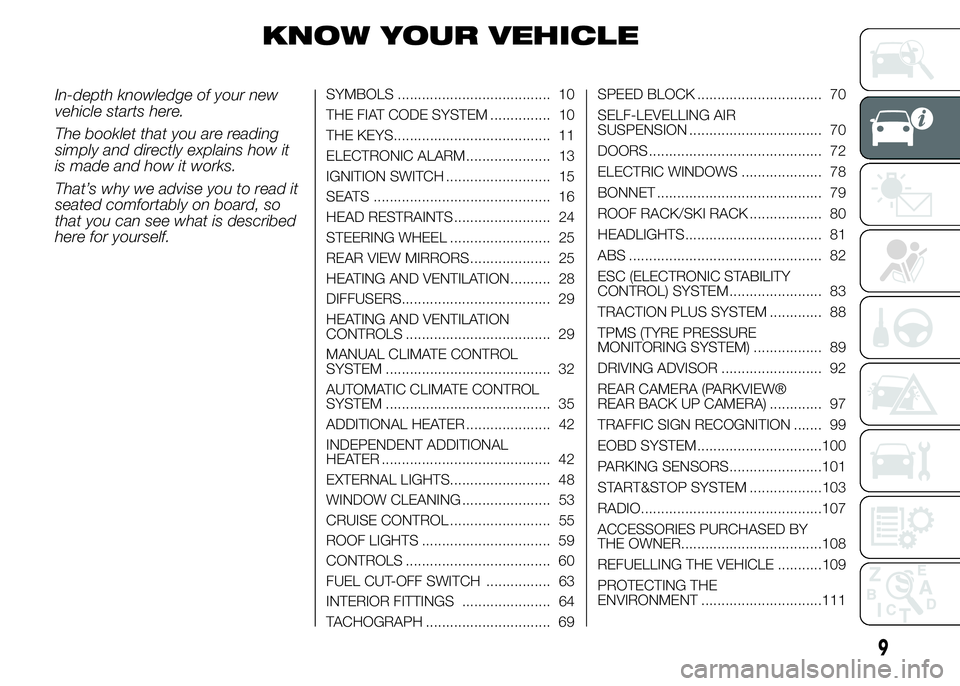
KNOW YOUR VEHICLE
In-depth knowledge of your new
vehicle starts here.
The booklet that you are reading
simply and directly explains how it
is made and how it works.
That’s why we advise you to read it
seated comfortably on board, so
that you can see what is described
here for yourself.SYMBOLS ...................................... 10
THE FIAT CODE SYSTEM ............... 10
THE KEYS....................................... 11
ELECTRONIC ALARM..................... 13
IGNITION SWITCH .......................... 15
SEATS ............................................ 16
HEAD RESTRAINTS ........................ 24
STEERING WHEEL ......................... 25
REAR VIEW MIRRORS .................... 25
HEATING AND VENTILATION.......... 28
DIFFUSERS..................................... 29
HEATING AND VENTILATION
CONTROLS .................................... 29
MANUAL CLIMATE CONTROL
SYSTEM ......................................... 32
AUTOMATIC CLIMATE CONTROL
SYSTEM ......................................... 35
ADDITIONAL HEATER ..................... 42
INDEPENDENT ADDITIONAL
HEATER .......................................... 42
EXTERNAL LIGHTS......................... 48
WINDOW CLEANING ...................... 53
CRUISE CONTROL ......................... 55
ROOF LIGHTS ................................ 59
CONTROLS .................................... 60
FUEL CUT-OFF SWITCH ................ 63
INTERIOR FITTINGS ...................... 64
TACHOGRAPH ............................... 69SPEED BLOCK ............................... 70
SELF-LEVELLING AIR
SUSPENSION ................................. 70
DOORS ........................................... 72
ELECTRIC WINDOWS .................... 78
BONNET ......................................... 79
ROOF RACK/SKI RACK .................. 80
HEADLIGHTS.................................. 81
ABS ................................................ 82
ESC (ELECTRONIC STABILITY
CONTROL) SYSTEM ....................... 83
TRACTION PLUS SYSTEM ............. 88
TPMS (TYRE PRESSURE
MONITORING SYSTEM) ................. 89
DRIVING ADVISOR ......................... 92
REAR CAMERA (PARKVIEW®
REAR BACK UP CAMERA) ............. 97
TRAFFIC SIGN RECOGNITION ....... 99
EOBD SYSTEM...............................100
PARKING SENSORS.......................101
START&STOP SYSTEM ..................103
RADIO.............................................107
ACCESSORIES PURCHASED BY
THE OWNER...................................108
REFUELLING THE VEHICLE ...........109
PROTECTING THE
ENVIRONMENT ..............................111
9
Page 19 of 367
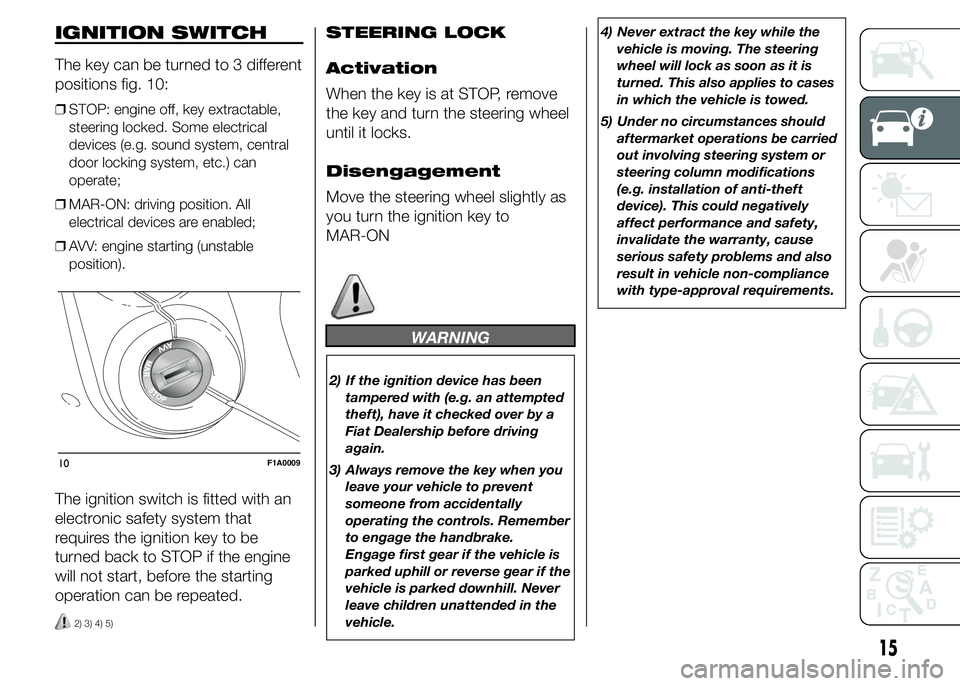
IGNITION SWITCH
The key can be turned to 3 different
positions fig. 10:
❒STOP: engine off, key extractable,
steering locked. Some electrical
devices (e.g. sound system, central
door locking system, etc.) can
operate;
❒MAR-ON: driving position. All
electrical devices are enabled;
❒AVV: engine starting (unstable
position).
The ignition switch is fitted with an
electronic safety system that
requires the ignition key to be
turned back to STOP if the engine
will not start, before the starting
operation can be repeated.
2) 3) 4) 5)
STEERING LOCK
Activation
When the key is at STOP, remove
the key and turn the steering wheel
until it locks.
Disengagement
Move the steering wheel slightly as
you turn the ignition key to
MAR-ON
WARNING
2) If the ignition device has been
tampered with (e.g. an attempted
theft), have it checked over by a
Fiat Dealership before driving
again.
3) Always remove the key when you
leave your vehicle to prevent
someone from accidentally
operating the controls. Remember
to engage the handbrake.
Engage first gear if the vehicle is
parked uphill or reverse gear if the
vehicle is parked downhill. Never
leave children unattended in the
vehicle.4) Never extract the key while the
vehicle is moving. The steering
wheel will lock as soon as it is
turned. This also applies to cases
in which the vehicle is towed.
5) Under no circumstances should
aftermarket operations be carried
out involving steering system or
steering column modifications
(e.g. installation of anti-theft
device). This could negatively
affect performance and safety,
invalidate the warranty, cause
serious safety problems and also
result in vehicle non-compliance
with type-approval requirements.
10F1A0009
15
Page 20 of 367
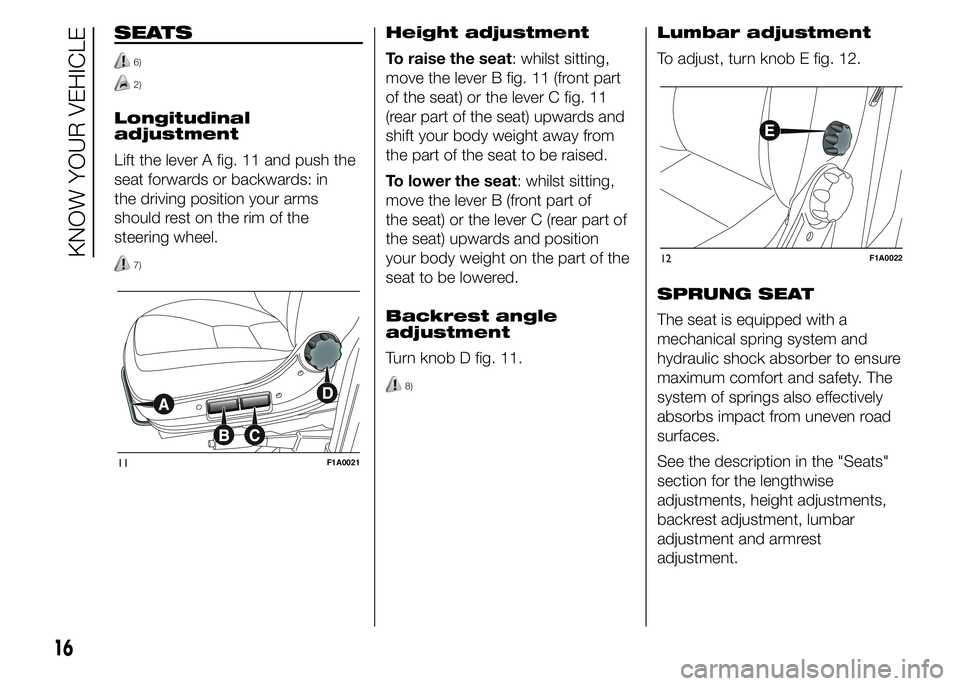
SEATS
6)
2)
Longitudinal
adjustment
Lift the lever A fig. 11 and push the
seat forwards or backwards: in
the driving position your arms
should rest on the rim of the
steering wheel.
7)
Height adjustment
To raise the seat: whilst sitting,
move the lever B fig. 11 (front part
of the seat) or the lever C fig. 11
(rear part of the seat) upwards and
shift your body weight away from
the part of the seat to be raised.
To lower the seat: whilst sitting,
move the lever B (front part of
the seat) or the lever C (rear part of
the seat) upwards and position
your body weight on the part of the
seat to be lowered.
Backrest angle
adjustment
Turn knob D fig. 11.
8)
Lumbar adjustment
To adjust, turn knob E fig. 12.
SPRUNG SEAT
The seat is equipped with a
mechanical spring system and
hydraulic shock absorber to ensure
maximum comfort and safety. The
system of springs also effectively
absorbs impact from uneven road
surfaces.
See the description in the "Seats"
section for the lengthwise
adjustments, height adjustments,
backrest adjustment, lumbar
adjustment and armrest
adjustment.
11F1A0021
12F1A0022
16
KNOW YOUR VEHICLE
Page 29 of 367
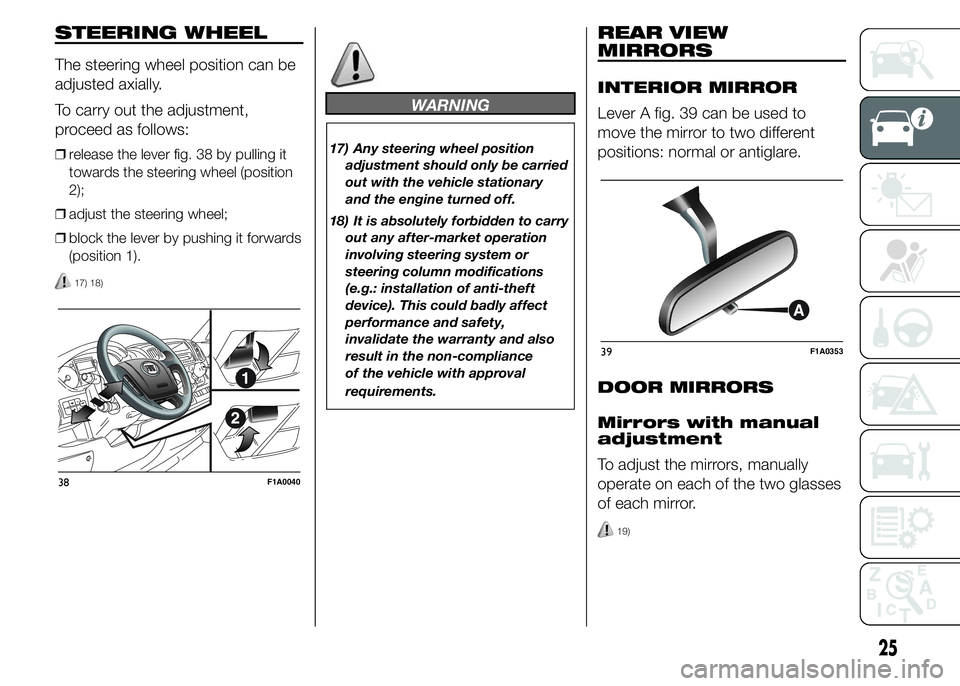
STEERING WHEEL
The steering wheel position can be
adjusted axially.
To carry out the adjustment,
proceed as follows:
❒release the lever fig. 38 by pulling it
towards the steering wheel (position
2);
❒adjust the steering wheel;
❒block the lever by pushing it forwards
(position 1).
17) 18)
WARNING
17) Any steering wheel position
adjustment should only be carried
out with the vehicle stationary
and the engine turned off.
18) It is absolutely forbidden to carry
out any after-market operation
involving steering system or
steering column modifications
(e.g.: installation of anti-theft
device). This could badly affect
performance and safety,
invalidate the warranty and also
result in the non-compliance
of the vehicle with approval
requirements.
REAR VIEW
MIRRORS
INTERIOR MIRROR
Lever A fig. 39 can be used to
move the mirror to two different
positions: normal or antiglare.
DOOR MIRRORS
Mirrors with manual
adjustment
To adjust the mirrors, manually
operate on each of the two glasses
of each mirror.
19)
38F1A0040
39F1A0353
25
Page 53 of 367
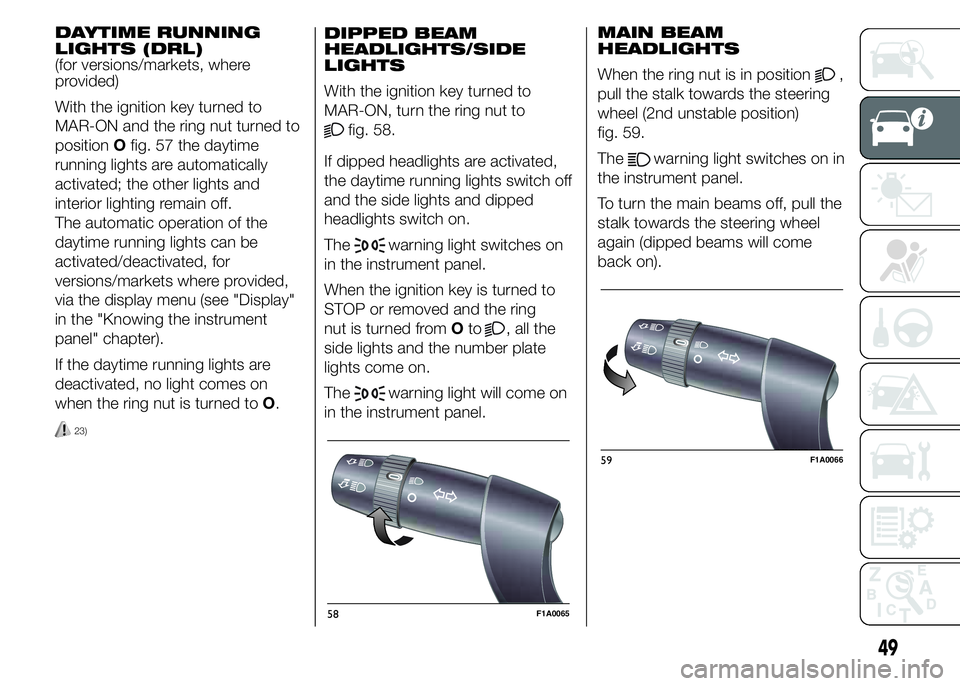
DAYTIME RUNNING
LIGHTS (DRL)
(for versions/markets, where
provided)
With the ignition key turned to
MAR-ON and the ring nut turned to
positionOfig. 57 the daytime
running lights are automatically
activated; the other lights and
interior lighting remain off.
The automatic operation of the
daytime running lights can be
activated/deactivated, for
versions/markets where provided,
via the display menu (see "Display"
in the "Knowing the instrument
panel" chapter).
If the daytime running lights are
deactivated, no light comes on
when the ring nut is turned toO.
23)
DIPPED BEAM
HEADLIGHTS/SIDE
LIGHTS
With the ignition key turned to
MAR-ON, turn the ring nut to
fig. 58.
If dipped headlights are activated,
the daytime running lights switch off
and the side lights and dipped
headlights switch on.
The
warning light switches on
in the instrument panel.
When the ignition key is turned to
STOP or removed and the ring
nut is turned fromOto
, all the
side lights and the number plate
lights come on.
The
warning light will come on
in the instrument panel.MAIN BEAM
HEADLIGHTS
When the ring nut is in position
,
pull the stalk towards the steering
wheel (2nd unstable position)
fig. 59.
The
warning light switches on in
the instrument panel.
To turn the main beams off, pull the
stalk towards the steering wheel
again (dipped beams will come
back on).
58F1A0065
59F1A0066
49
Page 54 of 367
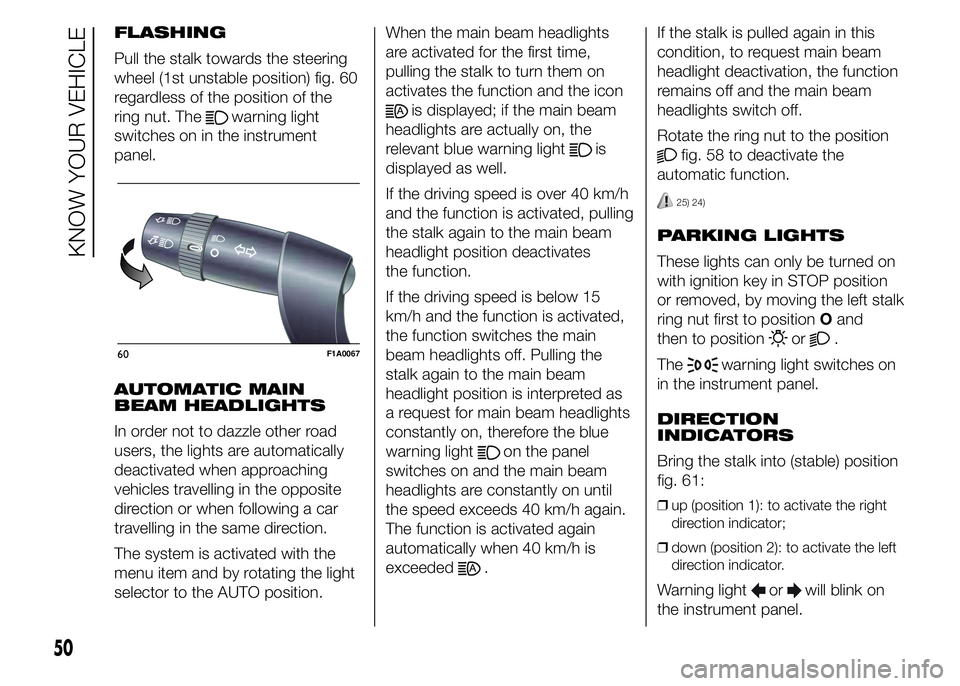
FLASHING
Pull the stalk towards the steering
wheel (1st unstable position) fig. 60
regardless of the position of the
ring nut. The
warning light
switches on in the instrument
panel.
AUTOMATIC MAIN
BEAM HEADLIGHTS
In order not to dazzle other road
users, the lights are automatically
deactivated when approaching
vehicles travelling in the opposite
direction or when following a car
travelling in the same direction.
The system is activated with the
menu item and by rotating the light
selector to the AUTO position.When the main beam headlights
are activated for the first time,
pulling the stalk to turn them on
activates the function and the iconis displayed; if the main beam
headlights are actually on, the
relevant blue warning light
is
displayed as well.
If the driving speed is over 40 km/h
and the function is activated, pulling
the stalk again to the main beam
headlight position deactivates
the function.
If the driving speed is below 15
km/h and the function is activated,
the function switches the main
beam headlights off. Pulling the
stalk again to the main beam
headlight position is interpreted as
a request for main beam headlights
constantly on, therefore the blue
warning light
on the panel
switches on and the main beam
headlights are constantly on until
the speed exceeds 40 km/h again.
The function is activated again
automatically when 40 km/h is
exceeded
.If the stalk is pulled again in this
condition, to request main beam
headlight deactivation, the function
remains off and the main beam
headlights switch off.
Rotate the ring nut to the position
fig. 58 to deactivate the
automatic function.
25) 24)
PARKING LIGHTS
These lights can only be turned on
with ignition key in STOP position
or removed, by moving the left stalk
ring nut first to positionOand
then to position
or.
The
warning light switches on
in the instrument panel.
DIRECTION
INDICATORS
Bring the stalk into (stable) position
fig. 61:
❒up (position 1): to activate the right
direction indicator;
❒down (position 2): to activate the left
direction indicator.
Warning lightorwill blink on
the instrument panel.
60F1A0067
50
KNOW YOUR VEHICLE
Page 55 of 367
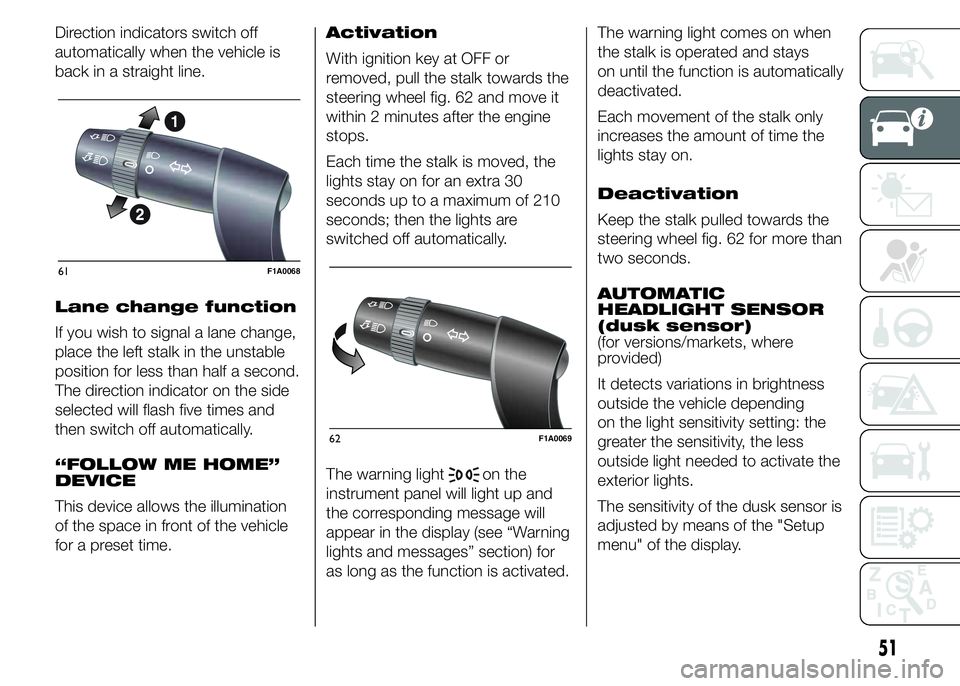
Direction indicators switch off
automatically when the vehicle is
back in a straight line.
Lane change function
If you wish to signal a lane change,
place the left stalk in the unstable
position for less than half a second.
The direction indicator on the side
selected will flash five times and
then switch off automatically.
“FOLLOW ME HOME”
DEVICE
This device allows the illumination
of the space in front of the vehicle
for a preset time.Activation
With ignition key at OFF or
removed, pull the stalk towards the
steering wheel fig. 62 and move it
within 2 minutes after the engine
stops.
Each time the stalk is moved, the
lights stay on for an extra 30
seconds up to a maximum of 210
seconds; then the lights are
switched off automatically.
The warning light
on the
instrument panel will light up and
the corresponding message will
appear in the display (see “Warning
lights and messages” section) for
as long as the function is activated.The warning light comes on when
the stalk is operated and stays
on until the function is automatically
deactivated.
Each movement of the stalk only
increases the amount of time the
lights stay on.
Deactivation
Keep the stalk pulled towards the
steering wheel fig. 62 for more than
two seconds.
AUTOMATIC
HEADLIGHT SENSOR
(dusk sensor)
(for versions/markets, where
provided)
It detects variations in brightness
outside the vehicle depending
on the light sensitivity setting: the
greater the sensitivity, the less
outside light needed to activate the
exterior lights.
The sensitivity of the dusk sensor is
adjusted by means of the "Setup
menu" of the display.
61F1A0068
62F1A0069
51
Page 57 of 367
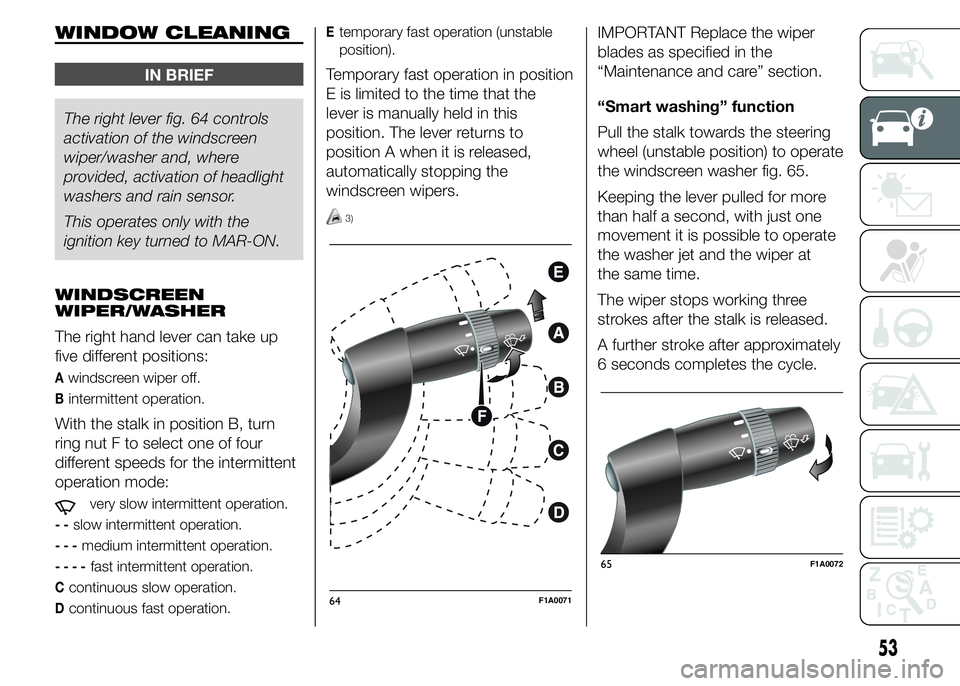
WINDOW CLEANING
IN BRIEF
The right lever fig. 64 controls
activation of the windscreen
wiper/washer and, where
provided, activation of headlight
washers and rain sensor.
This operates only with the
ignition key turned to MAR-ON.
WINDSCREEN
WIPER/WASHER
The right hand lever can take up
five different positions:
Awindscreen wiper off.
Bintermittent operation.
With the stalk in position B, turn
ring nut F to select one of four
different speeds for the intermittent
operation mode:
very slow intermittent operation.
--slow intermittent operation.
---medium intermittent operation.
----fast intermittent operation.
Ccontinuous slow operation.
Dcontinuous fast operation.
Etemporary fast operation (unstable
position).
Temporary fast operation in position
E is limited to the time that the
lever is manually held in this
position. The lever returns to
position A when it is released,
automatically stopping the
windscreen wipers.
3)
IMPORTANT Replace the wiper
blades as specified in the
“Maintenance and care” section.
“Smart washing” function
Pull the stalk towards the steering
wheel (unstable position) to operate
the windscreen washer fig. 65.
Keeping the lever pulled for more
than half a second, with just one
movement it is possible to operate
the washer jet and the wiper at
the same time.
The wiper stops working three
strokes after the stalk is released.
A further stroke after approximately
6 seconds completes the cycle.
64F1A0071
65F1A0072
53
Page 87 of 367
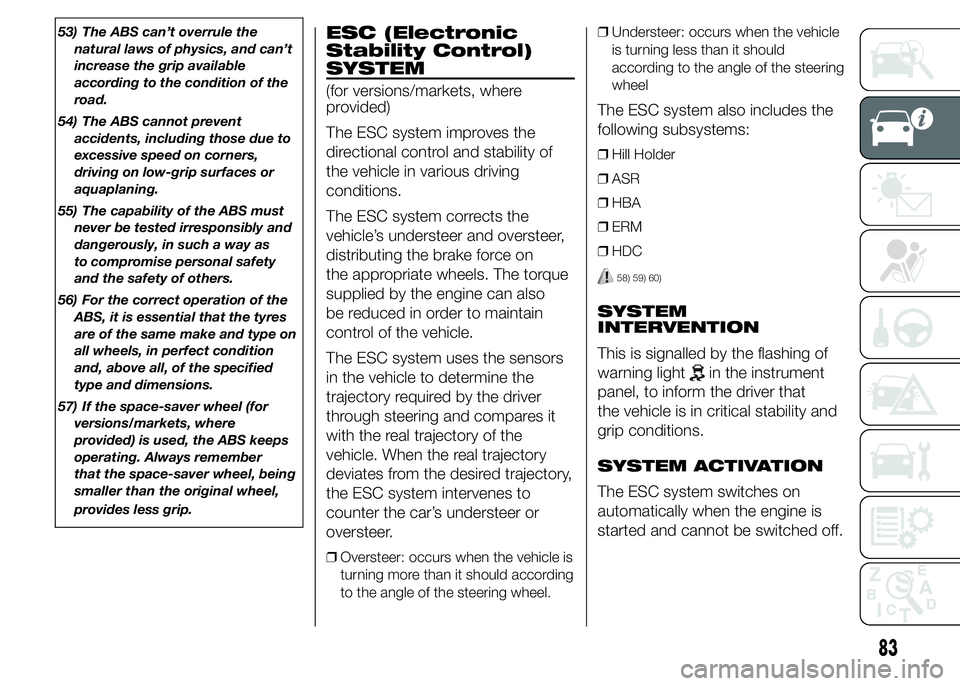
53) The ABS can’t overrule the
natural laws of physics, and can’t
increase the grip available
according to the condition of the
road.
54) The ABS cannot prevent
accidents, including those due to
excessive speed on corners,
driving on low-grip surfaces or
aquaplaning.
55) The capability of the ABS must
never be tested irresponsibly and
dangerously, in such a way as
to compromise personal safety
and the safety of others.
56) For the correct operation of the
ABS, it is essential that the tyres
are of the same make and type on
all wheels, in perfect condition
and, above all, of the specified
type and dimensions.
57) If the space-saver wheel (for
versions/markets, where
provided) is used, the ABS keeps
operating. Always remember
that the space-saver wheel, being
smaller than the original wheel,
provides less grip.ESC (Electronic
Stability Control)
SYSTEM
(for versions/markets, where
provided)
The ESC system improves the
directional control and stability of
the vehicle in various driving
conditions.
The ESC system corrects the
vehicle’s understeer and oversteer,
distributing the brake force on
the appropriate wheels. The torque
supplied by the engine can also
be reduced in order to maintain
control of the vehicle.
The ESC system uses the sensors
in the vehicle to determine the
trajectory required by the driver
through steering and compares it
with the real trajectory of the
vehicle. When the real trajectory
deviates from the desired trajectory,
the ESC system intervenes to
counter the car’s understeer or
oversteer.
❒Oversteer: occurs when the vehicle is
turning more than it should according
to the angle of the steering wheel.❒Understeer: occurs when the vehicle
is turning less than it should
according to the angle of the steering
wheel
The ESC system also includes the
following subsystems:
❒Hill Holder
❒ASR
❒HBA
❒ERM
❒HDC
58) 59) 60)
SYSTEM
INTERVENTION
This is signalled by the flashing of
warning light
in the instrument
panel, to inform the driver that
the vehicle is in critical stability and
grip conditions.
SYSTEM ACTIVATION
The ESC system switches on
automatically when the engine is
started and cannot be switched off.
83